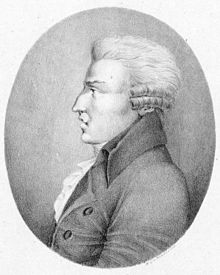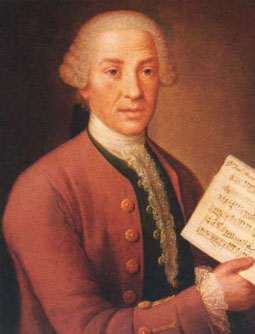

Francesco Durante
Born: 1684Died: 1755
Education: Conservatorio dei poveri di Gesù Cristo, in Naples, where he received lessons from Gaetano Greco, a pupil of Alessandro Scarlatti at the Conservatorio di Sant'Onofrio, studied under Bernardo Pasquini and Giuseppe Ottavio Pitoni in Rome
Career: succeeded Scarlatti in 1725 at Sant' Onofrio, and to have remained there until 1742, when he succeeded Porpora as head of the Conservatorio di Santa Maria di Loreto, also in Naples. This post he held for thirteen years
Francesco Durante was the seventh of 11 children of Gaetano Durante and Orsola Capasso. His father, a woolcomber, served as sexton and singer at S Maria degli Angeli e S Sossio, Frattamaggiore, where he and his wife had married on October 31, 1674 and where all their children were baptized. His uncle, Don Angelo Durante (c1650 - after 1704), was a priest and musician who in 1690 succeeded Cristoforo Caresana as primo maestro of the Neapolitan Conservatorio di S Onofrio a Capuana, of which he was rector until 1699. Don Angelo composed several drammi sacri (Gara amorosa tra Cileo, la Terra e ’l Mare, Monteforte, 1697; S Giuliano martire in Sora, Naples, 1700; L’Anacoreta reale S Onofrio di Persia, Naples, 1705), as well as church music, of which a Dies irae attributed to him is extant (two voices and continuo, D-BNu). Nothing is known of Francesco’s education until after his father’s death on March 18, 1699, when his uncle took over his musical training. Don Angelo left Naples to assist his widowed sister-in-law and her children, and Nicola Sabini assumed his duties at the conservatory; but in 1702 he returned to his post at S Onofrio and Francesco enrolled as a convittore to study with his uncle and the violinist Gaetano Francone. Three years later Francesco left the conservatory, and on June 13, 1705 his first known creative effort, a scherzo drammatico entitled Prodigii della divina misericordia verso I devoti del glorioso S Antonio di Padova, was performed in Naples. Little is known about Francesco Durante’s life between then and 1728, when he was appointed primo maestro of the Neapolitan Conservatorio dei Poveri di Gesù Cristo. Choron and Fayolle (1810) stated that he studied with Pasquini and Pitoni in Rome for five years, and although that was later disavowed (by Villarosa and Florimo), circumstantial evidence seems to support them. Girolamo Chiti, in a letter to Padre Martini of September 10, 1746, identified Durante as a ‘scolaro di Pitoni’; Chiti himself had been a pupil of Pitoni about 1713, so his statement has some authority. Durante could have been in Rome either between 1705 and 1710, which would have allowed studies with Pasquini (who died in 1710), or between 1711 and 1719. The only dated composition by Durante from the first period, his Missa S Ildefonsi of 1709, could have been written for the Spanish church in Rome or Naples. By July 1710 he was in Naples, where he began teaching at the Conservatorio di S Onofrio. He remained there for only six months, leaving the institution on 12 January 1711, perhaps to return to Rome or to study there with Pitoni for the first time. A register of the masters and professors of the Congregazione and Accademia di S Cecilia in Rome, compiled in 1851, lists Durante as a maestro there for 1718, but offers no documentation. Several aspects of Durante’s music have been interpreted as pointing to Roman influences: his concentration on sacred music to the exclusion of opera, his preoccupation with the problems of a stile alla Palestrina, and his interest in keyboard music and the concerto. He was, however, in Naples on January 4, 1714, when he married Orsola de Laurentis, 12 years his senior, and is certain to have been present in the city at the first performance of his sacred drama La cerva assetata ovvero L’anima nelle fiamme on February 18, 1719. Thereafter, nothing is known of Durante’s whereabouts until 1728. It could have been during these years that he travelled to Austria [Bohemia] and Saxony, as some older sources report (though for periods when he now is known to have resided in Naples). There is, however, no documentary evidence other than some unique sacred works attributed to Durante that are preserved in Brno, Prague and Dresden in local manuscript copies dating from the early to mid-1720s. In October 1728 the governors of the Conservatorio dei Poveri di Gesù Cristo appointed Francesco Durante, now aged 44, primo maestro replacing the elderly Gaetano Greco: his election attests to his high reputation. About the same time he must have been invited to write music for the choruses of Duke Annibale Marchese’s tragedy Flavio Valente, published in the duke’s Tragedie cristiane (Naples, 1729). With this contribution he joined the ranks of the then celebrated older and younger Neapolitan composers, Carapella, Mancini, Sarro, Nicola Fago, Nicola Porpora, Hasse, Vinci and Leo, who had written music for other tragedies in the collection. Dated copies of his compositions now become more numerous: a Litanie (1731), Laudate pueri (1732),Missa breve (1734), and the oratorio Abigaile (libretto, 1736). His well-known Sonate per cembalo divisi in studii e divertimenti, however, were not published in Naples in 1732, as has been assumed, but between January 1747 and December 1749, since the dedication refers to the Principe d’Ardore, Don Giacomo Francesco Milano as ambassador to France (which he was between 1741 and 1749) and as Cavaliere di Santo Spirito (which he was named in January 1747). The prince, a student of Durante, dedicated a Salve regina for one voice and instruments ‘al suo maestro Francesco Durante’ D-MÜs, WRgs). Durante’s Requiem in G minor is dated November 27, 1738, and his Missa in Palestrina (in a copy by Famulari) October 17-18, 1739. Also from those years come the two Atti di Contrizioni for the alumni of the Conservatorio dei Poveri di Gesù Cristo. Among his students there were Giovanni Battista Pergolesi, who completed his education under Durante’s guidance, Girolamo Abos, Domenico Terradellas and for about two years Joseph Doll. After ten years of service, Francesco Durante resigned from the conservatory, and in September 1739 he was succeeded by Francesco Feo. The reasons for his resignation are unknown, and there is no information about his activities until 1742, when he was called to the Neapolitan Conservatorio di S Maria di Loreto. This oldest and largest of the four Neapolitan conservatories had been without a primo maestro since October 1741, when Nicola Porpora went on leave to Venice and did not return; with the death of Giovanni Veneziano on April 13, 1742 it had lost its secondo maestro. On April 25, 1742 the governors elected Durante primo maestro, at the same time appointing P.A. Gallo to assist him as secondo maestro. Under Durante’s directorship the Loreto conservatory regained stability and quality of education. During his 13 years’ service such later masters as Pasquale Anfossi, Tommaso Traetta, Pietro Guglielmi, Alessandro Speranza, Antonio Sacchini and Fedele Fenaroli received their musical education there. When, with the death of Leo on October 31, 1744, the primo maestro position at the Conservatorio di S Onofrio became vacant, Durante, then 60, was awarded the succession as from January 1, 1745. He also petitioned the king to appoint him Leo’s successor as primo maestro of the royal chapel. A competition, however, was held, in which Durante took part on April 21, 1745 along with Giuseppe de Majo, Giuseppe Marchitti, Nicola Sala and others. The judges were Constanzi of Rome, Perti of Bologna, Jommelli of Venice, and Hasse, then also in Venice. Jommelli praised Durante’s a cappella setting on the cantus firmus Protexisti me Deus, of which Perti was critical; the appointment went to Majo, vicemaestro of the chapel (although only Hasse had found his works satisfactory). Durante continued to hold his positions at both S Maria di Loreto and S Onofrio, and during the last ten years of his life was venerated as the most distinguished of all Neapolitan teachers. According to tradition Nicolo Piccinni became Durante’s favourite pupil, of whom he is supposed to have said: ‘The others are my pupils, but Nicolo alone is my son’. Dated compositifrom his last decade include the five-voice Miserere for the basilica of S Nicola, Bari, the Requiem in C minor for eight voices, performed in 1746 at S Giacomo degli Spagnoli in Rome, an F major mass (1749), the F minor Litany (1750), and the componimento sacro S Antonio di Padova (1753). Francesco Durante married three times. His first wife died on February 27, 1741; early biographies characterized her as a ‘maledetta vecchia’ who made the 27 years of their marriage a misery. On January 26, 1744 he married his second wife, Anna Furano, of Naples, who is said to have brought happiness back into his life; but she died on August 10, 1747. Only four months later, on December 18, 1747, he was married again, to the 22-year-old Angela Anna Carmina Giacobbe, the niece of Anna Furano and a domestic in his household. Reports of Durante’s character and personality are primarily based on anecdotes related by Giuseppe Sigismondo, who had known the composer, and by Giovanni Furno, who related stories he had heard from his teacher Carlo Cotumacci, Durante’s successor at S Onofrio. According to these sources Durante was a man of simple manners, but profoundly wise in matters concerning his art and a respected arbiter over questions of harmony and counterpoint. He was dedicated to his pupils’ welfare and education; they in turn, like Paisiello, who began his studies at S Onofrio during the last year of Durante’s life, always spoke of him with enthusiasm and admiration. He was buried in S Lorenzo Maggiore in Naples.

